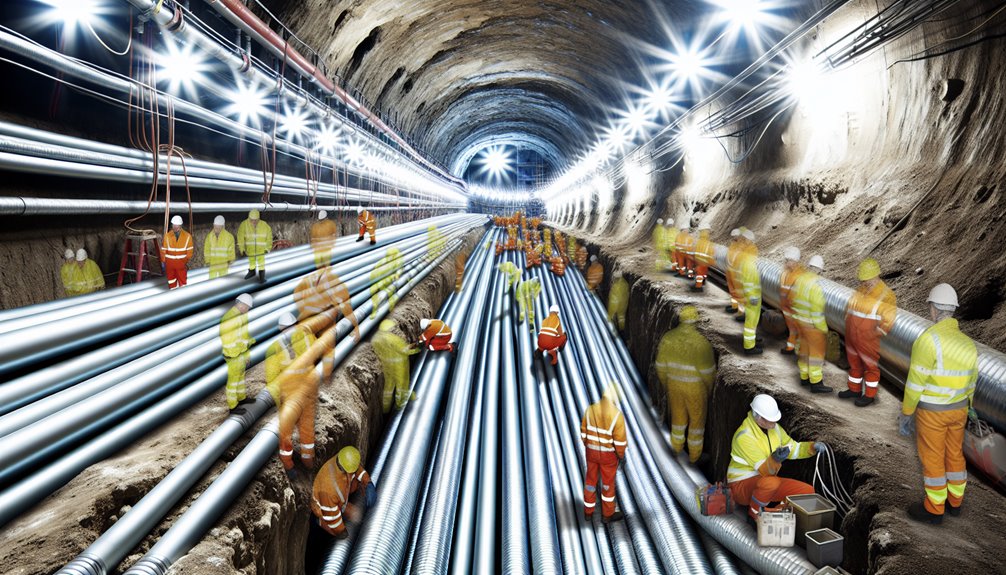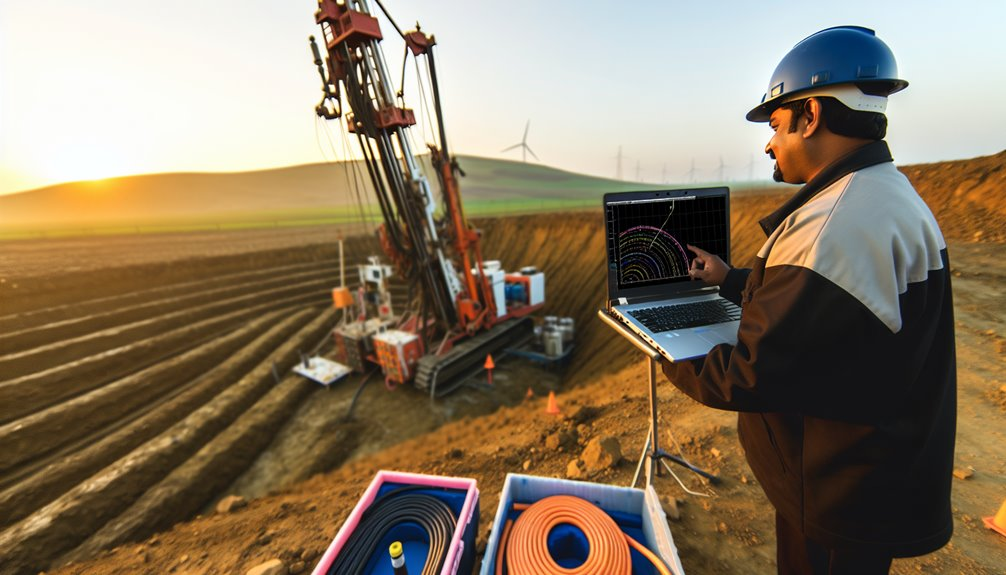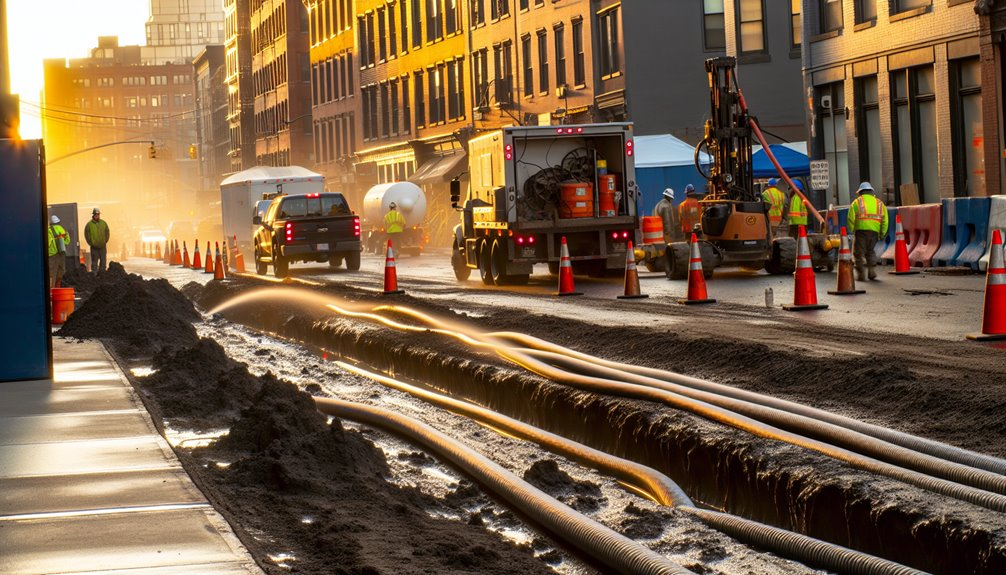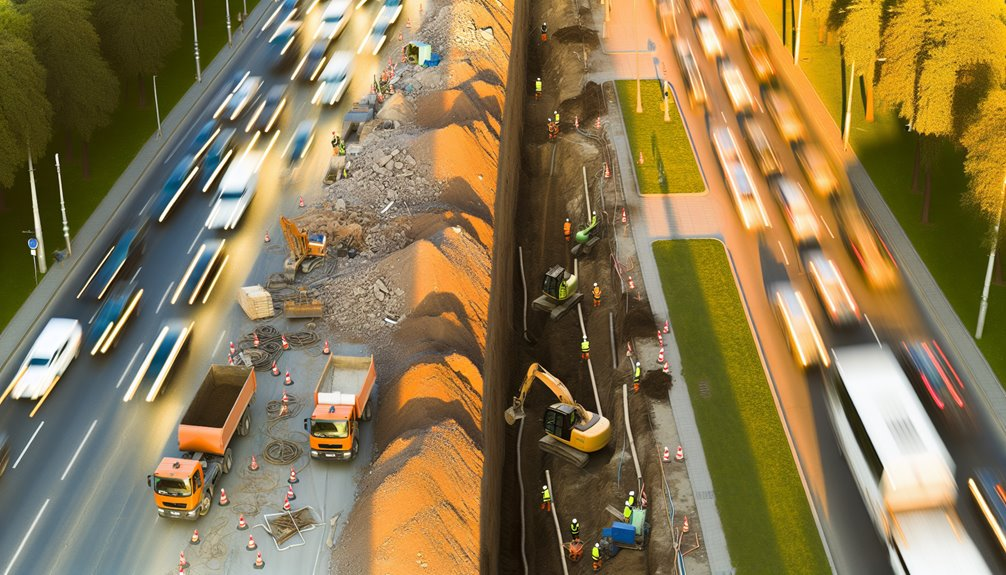As you explore successful underground utility construction projects, you'll encounter the marvels of engineering such as the Channel Tunnel and Singapore's Deep Tunnel Sewerage System. These projects showcase not just technical prowess but also strategic foresight in urban planning. They tackle issues from traffic congestion to wastewater management, employing advanced tunneling technologies and rigorous safety protocols. Consider the complexities and multifaceted benefits of these initiatives; they offer a blueprint for future urban infrastructure development. What other insights might these case studies reveal about the intersection of technology and sustainability?
The Channel Tunnel: Revolutionizing Rail Travel Between the UK and France
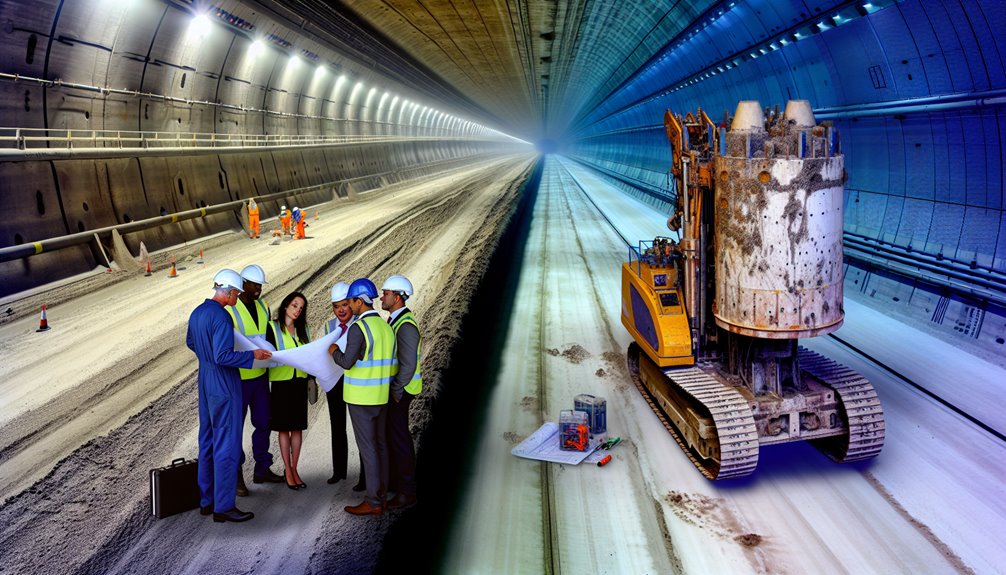
Tunnelling for the Channel Tunnel began in 1988, sparking a monumental six-year engineering feat that culminated in its 1994 inauguration. You're looking at a marvel of tunnel engineering, where eleven tunnel boring machines (TBMs) were deployed, uniquely split between the UK and France, showcasing effective cross-border collaboration. The dual 7.6 m diameter rail tunnels, set 30 m apart with an intermediary 4.8 m service tunnel, utilized the chalk marl's favorable properties for a stable, impermeable structure. Innovations like earth pressure balance machines were critical, preventing collapse under the Channel's immense pressures and maintaining environmental integrity. This project not only advanced rail travel but also set a high standard for international engineering projects. Additionally, the tunnel's strategic depth of up to 75 meters below the seabed ensured enhanced safety and operational reliability, addressing both engineering challenges and environmental concerns.
The Deep Tunnel Sewerage System, Singapore: A Pioneering Approach
As Singapore faces the complex challenge of urban water management, the Deep Tunnel Sewerage System (DTSS) emerges as a groundbreaking solution. This massive, sustainable infrastructure project not only enhances urban resilience but also sets a global benchmark in engineering innovation.
Key Highlights:
- Longevity and Scale: Designed to last a century, DTSS spans two phases covering the entire island, ensuring a robust framework for future expansions.
- Technological Mastery: Utilizing advanced tunnel boring machines and innovative corrosion protection, it exemplifies cutting-edge engineering tailored to overcome Singapore's unique geological challenges.
- Environmental Impact: By centralizing wastewater treatment and enhancing NEWater production, DTSS considerably contributes to Singapore's water sustainability, turning urban water management into an exemplar of environmental stewardship.
The construction of DTSS involved deploying 19 Herrenknecht tunnel boring machines, a testament to the scale and technological sophistication of the project. These machines played a pivotal role in tunnelling 49 kilometers of deep underground sewer systems, marking a significant feat in civil engineering.
The Boston Big Dig: Transforming City Infrastructure
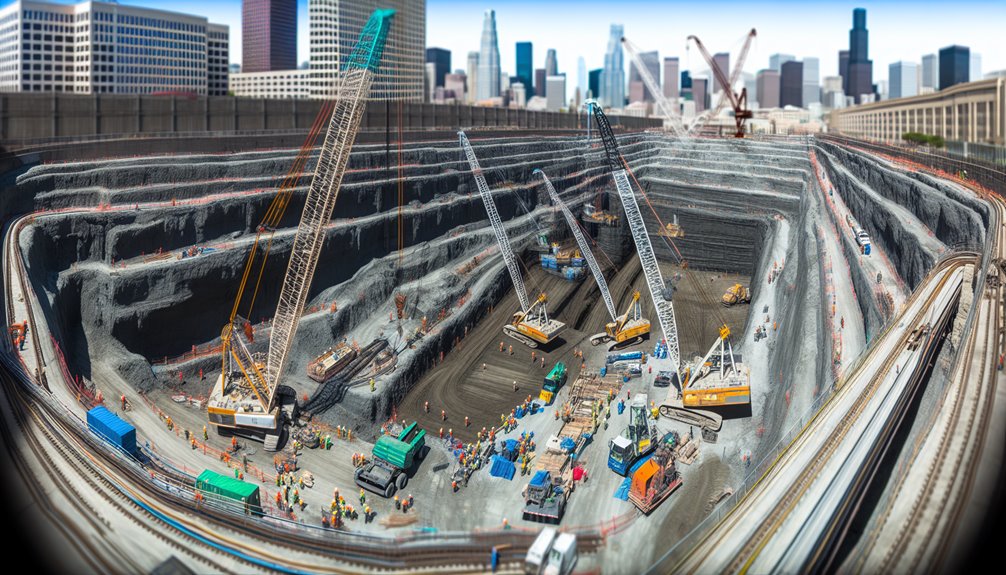
As you examine the Boston Big Dig, consider how innovative engineering solutions were central to its execution.
The project not only submerged a major highway into a 3.5-mile tunnel but also integrated a complex multilevel interchange system that revolutionized urban traffic flow in Boston.
These engineering feats addressed critical congestion issues while enhancing the city's infrastructure resilience and operational efficiency.
Innovative Engineering Solutions
To revolutionize city infrastructure, engineers employed the tunnel jacking technique beneath eight bustling Amtrak and MBTA railway tracks near South Station during the Boston Big Dig. This innovative method involved three jacked precast concrete boxes and three jacking pits, showcasing a pinnacle of construction innovation and sustainable engineering.
Here's how it touched lives:
- Preserved Essential Services: By avoiding disruptions on critical rail services, the project safeguarded daily commutes and economic activities, ensuring a seamless urban flow.
- Cost Efficiency: The technique saved millions in potential revenue losses, illustrating fiscal prudence alongside engineering prowess.
- Award-Winning Innovation: Garnering both national and international accolades, this approach set new benchmarks for how complex urban challenges should be tackled, inspiring future projects worldwide.
Impact on Urban Traffic
While the Boston Big Dig is often remembered for its complex engineering feats, its transformative impact on urban traffic can't be overstated.
You've witnessed a 62% improvement in traffic flow, drastically reducing vehicle-hours from 38,200 to 14,800 daily. This reconfiguration has slashed peak travel times on I-93 northbound during afternoon hours by an impressive 85.6%. Furthermore, your journey from the I-90/I-93 interchange to Logan Airport now takes 54% less time, enhancing urban mobility considerably.
Separation of co-mingled traffic streams and direct routes through the Ted Williams Tunnel have streamlined east-west travel, propelling traffic improvements further.
The addition of lanes and direct connections has optimized traffic flow, embodying a forward-thinking approach to urban planning and mobility.
The Los Angeles Outfall Tunnel: Enhancing Wastewater Management
As you examine the Los Angeles Outfall Tunnel, consider the project design challenges, particularly how the tunnel's route navigates through complex geologies and fault zones.
You'll also find that mitigating environmental impacts is essential, especially given the presence of volatile organic compounds and hydrocarbons in the Wilmington Oil Field.
These factors necessitate meticulous planning and advanced engineering solutions to guarantee both environmental safety and project efficacy.
Project Design Challenges
Designing the Los Angeles Outfall Tunnel posed significant challenges due to the diverse and unpredictable geological conditions along its planned route.
You're traversing through a maze of varying soil types and complex rock formations, making tunnel alignment challenges a focal point of the design process.
- Tunnel Alignment Challenges: You'll encounter heterogeneous soils and multiple major fault zones, requiring precise geotechnical monitoring to guarantee safety and accuracy.
- Geotechnical Monitoring Investment: Over $7 million is dedicated to monitoring, using advanced technologies to track and adapt to underground conditions in real-time.
- Adaptation to Geological Diversity: The use of a Herrenknecht slurry TBM allows for adaptation to the mixed underground environment, assuring consistent progress despite the geological complexities.
Environmental Impact Mitigation
To mitigate the environmental impact of the Los Angeles Outfall Tunnel project, rigorous measures are in place.
The new tunnel's design meets current earthquake standards, greatly reducing risks related to seismic activity. It's engineered to handle peak storm flows, thereby averting the risk of untreated wastewater entering local waterways—a pivotal step in water quality protection.
Construction strategies like the temporary bypass system guarantee the old tunnels operate seamlessly during upgrades, embodying sustainability practices.
Noise barriers and the strategic use of an access shaft at the JWPCP minimize surface and auditory disruptions, respecting nearby communities.
Your engagement in this initiative not only supports environmental stewardship but also bolsters community involvement, guaranteeing that local voices and needs are integral to project execution and success.
Crossrail London: A New Era in Urban Transit
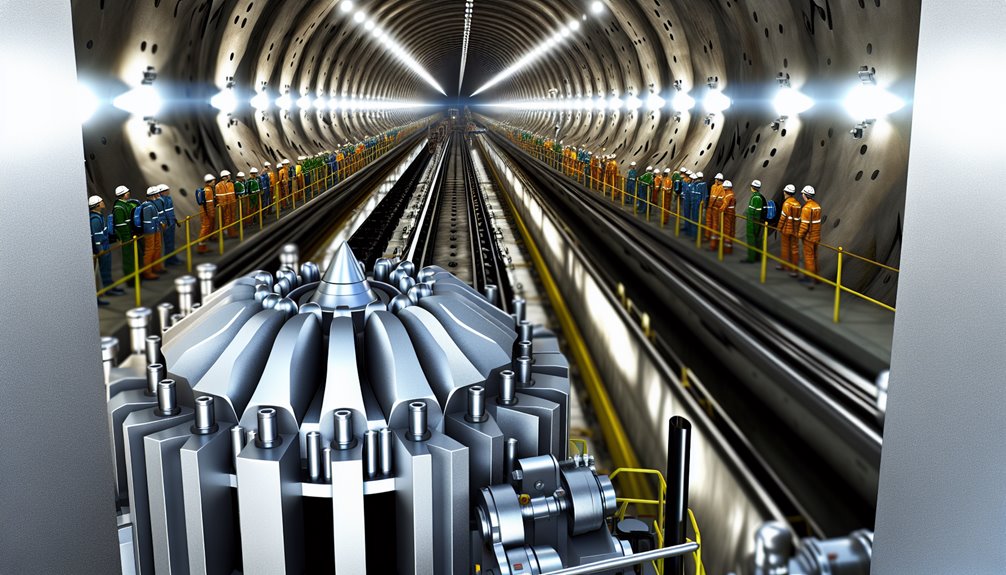
Initiating in 2009, the Crossrail project has fundamentally transformed London's approach to urban transit with the introduction of the Elizabeth line.
You've witnessed how strategic tunneling and station construction, despite the hurdles, bolstered London's infrastructure.
Here's what this project means for you:
- Transformed Connectivity: You're now part of a city where 1.5 million more people can access central London in under 45 minutes, massively enhancing your urban mobility.
- Economic Boost: You're contributing to a venture that adds an estimated £42 billion to the UK's economy.
- Enhanced Capacity: You're riding a line that increases central London's rail capacity by 10%, making your journeys more frequent and reliable.
Each element was meticulously engineered to keep London moving forward, despite significant construction challenges and delays.
The Emscher Sewer Project: Revitalizing the Ruhr
The Emscher Sewer Project, Europe's largest wastewater treatment initiative, has dramatically reshaped the Ruhr area's approach to environmental management.
Through the implementation of a 51 km underground wastewater tunnel and a sophisticated network of conduits and pumping stations, you're witnessing a pivotal transformation in the Emscher restoration efforts. This project not only tackles the legacy of pollution but also revolutionizes wastewater management by ensuring efficient flow and treatment across the region, serving over 1.8 million people.
Technically, it employs a gradient of 1.5 m per kilometer in the tunnel, facilitating natural wastewater movement, while high-efficiency pumps optimize energy use.
The strategic use of mechanized tunneling with segmental lining addresses the challenging Emscher marl, enhancing the project's engineering integrity and environmental impact.
Sydney's North West Rail Link: Tunneling Down Under
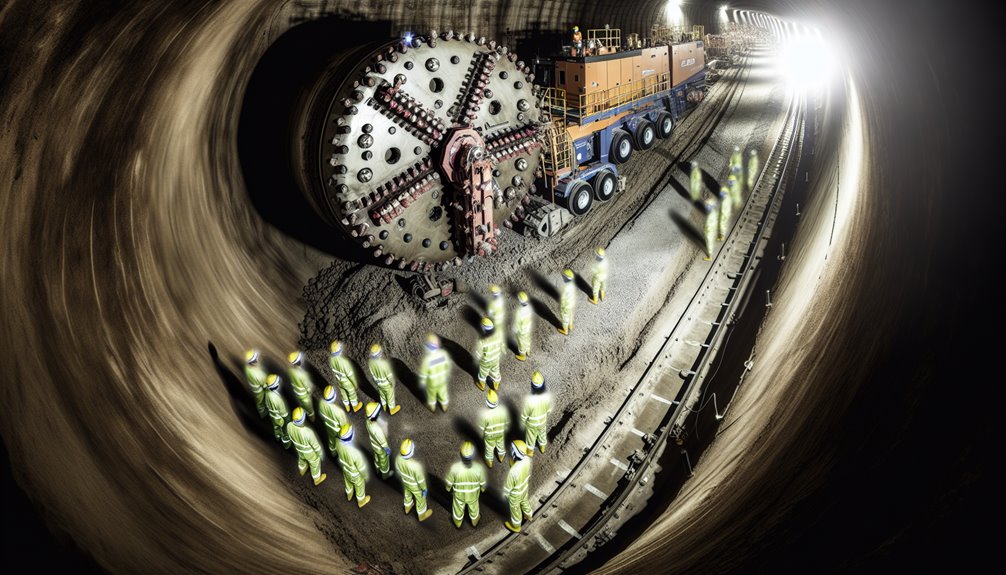
Shifting focus from the Emscher Sewer Project in Europe, let's explore another groundbreaking infrastructure development: Sydney's North West Rail Link, a key component in modernizing Australia's transport systems.
With 15.5 kilometers of twin bore tunnels constructed through innovative tunnel engineering techniques, this project exemplifies state-of-the-art infrastructure development. Utilizing double shield hard rock TBMs guaranteed minimal disruption and precision in the dense geological settings of the Sydney Basin.
Here are three compelling aspects:
- Innovative Tunneling: Leveraged cutting-edge TBMs to navigate complex geology.
- Strategic Project Financing: Achieved financial close with a robust consortium, guaranteeing a $3.7 billion investment was well managed.
- Community Impact: Enhanced connectivity and reduced travel times dramatically, promoting economic growth and urban development.
The SMART Tunnel, Kuala Lumpur: Multipurpose Flood and Traffic Solution
As we explore the SMART Tunnel in Kuala Lumpur, a pioneering solution emerges, addressing both chronic urban flooding and severe traffic congestion simultaneously.
This 9.7 km infrastructure marvel, part of an astute urban planning initiative, integrates a dual-purpose system—flood prevention and traffic management. It adeptly diverts stormwater from flood-prone areas to safe release points, markedly mitigating urban flooding risks, particularly around the critical Klang River and Masjid Jamek zones.
Simultaneously, its 3 km double-deck motorway section slashes travel times dramatically, transforming a typical 15-minute journey into a swift four minutes.
This model of multipurpose utility construction not only exemplifies innovative engineering but also underscores the strategic interplay between infrastructure development and urban resilience.
The Copenhagen Metro: Expanding Urban Transport Efficiently
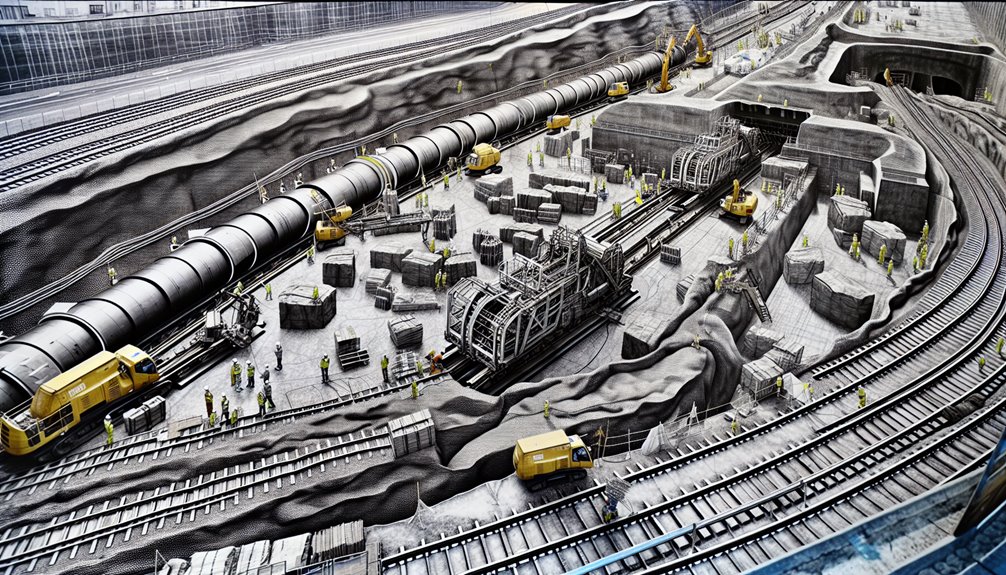
When considering the expansion of urban transport systems, Copenhagen's M4 metro extension stands out as a model of efficient infrastructure development. This extension not only enhances metro connectivity but also plays a pivotal role in the broader urban redevelopment of the Southern Harbour area.
Here's what makes it exemplary:
- Seamless Integration: It connects diverse urban districts, drastically reducing travel times—Copenhagen South to Rådhuspladsen in just 10 minutes.
- Strategic Connectivity: The extension facilitates interchange opportunities across multiple lines, integrating new and existing zones, which boosts the area's accessibility and economic potential.
- Innovative Funding: Utilizing value capture for funding reflects a sustainable approach, aligning increased land value with infrastructure improvements to support the project financially.
This project showcases how targeted infrastructure investment can transform urban living landscapes.
Conclusion
By examining these case studies, you've seen how underground utility projects can revolutionize urban environments. From enhancing rail connectivity, like the Channel Tunnel, to innovative wastewater solutions in Singapore and Los Angeles, these initiatives boost both infrastructure efficiency and sustainability. As you move forward, remember the importance of integrating advanced technologies and thorough planning to guarantee safety and environmental compatibility. These projects aren't just about construction—they're about creating smarter, more livable cities for the future.
If you're curious to learn more about how underground utility construction can transform your community, I invite you to visit Boring Bros at boringbro.com. You can also give them a call at (954) 639-6167. They're always ready to share insights and help you explore the possibilities. Let's create a better future together!

